There are certain items or products that are immediately associated with a given country, for example: ice hockey and Canada, beer and Germany, haute cuisine and France, hot dogs and the USA, and vodka and Russia. As a first generation Italian-American kid growing up in New Jersey, I secretly associated Italy with just one magical product, and it wasn’t Ferrari or Soccer (calcio), but rather salami! Yes, salami (or salumi, as the Italians would say), that seductive product comprised of salty / cured / spiced perfection!
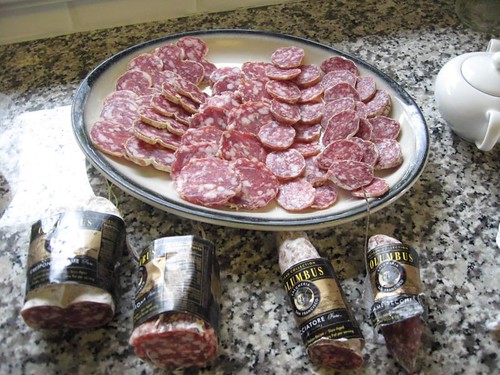
(photo: I sliced up four different types of Columbus Artisan product for a Thanksgiving appetizer)
![IMG_4807[1]](http://farm3.static.flickr.com/2566/4139163864_96b08b030a.jpg)
(photo: I think the packaging on the Creminelli product is top notch!)
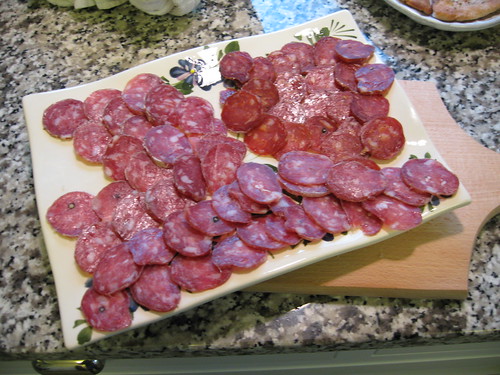
(photo: starting from upper right clockwise: Creminelli Piccante, Sopressata, and Cacciatore)
Creminelli Sopressata
Sopressata is traditionally made with wine and garlic and Creminelli’s sopressata was no different, yet the wine and garlic flavor was muted letting the intensity and quality of the pork come through. The meat to fat ratio was also ideal, which is tough to get right in Sopressata. I would have preffered a bit more garlic flavor in the Sopressata and little bit less upfront salt but overall it is a fine salumi. Creminelli Sopressata would work well in a sandwhich combined with other ingredients.
Creminelli Picante
My favorite of the bunch and not overly spiced with red pepper. The salt content was perfect in the Picante and the combination of high quality pork with mild heat made me quite happy. The color of the Picante was also well done, it’s not the typical fiery red color you see in most spiced salami.
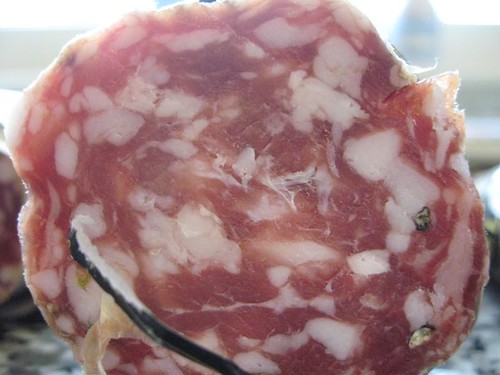
(photo: Columbus Artisan Cacciatore)
Creminelli Cacciatore
The first thing that jumped out was the subtle juniper berry flavor in the Cacciatore! Moreover, the consistency and texture was typical old world, as was the physical size of the sausage itself (very small; afterall, tradition has it that hunter’s stored the salami in their coats and when they got hungry in the forest they simply cut a few pieces and had a quick bite). Next to the Piccante, I really enjoyed the Cacciatore. There were some bitter components (at the very end) that may have been coming out of homemade wine I was having when sampling the salami, but overall you could tell that high quality ingredients were used in production. Finally, this salami also had a wonderful scent! This is a great all around salami to keep in the house for a quick meal on the weekend or for impromptu quests.
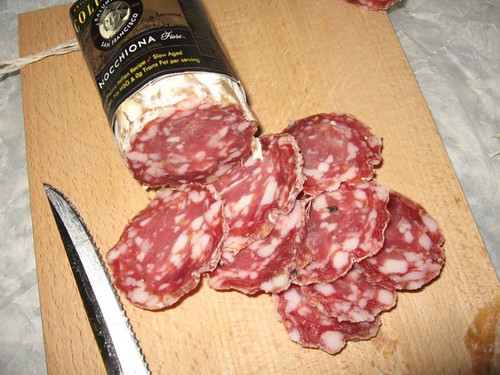
(photo: Columbus Artisan Finocchiona, my favorite amongst both the Creminelli and Columbus products)
Columbus Artisan Finocchiona
Let me qualify the following sentence first by saying that fennel seed was one of the key ingredients in my grandfather’s salumi making arsenal and, as a result, I’ve been pre-programmed to respond positively to fennel flavor. And there’s tons of authentic fennel seed flavor in the Finocchiona, in fact it was my favorite salumi out of the 9 products sampled. The Finocchiona had great texture, rich and flavorful pork, and the perfect balance of salt and bitter that is needed in any artisan salami.
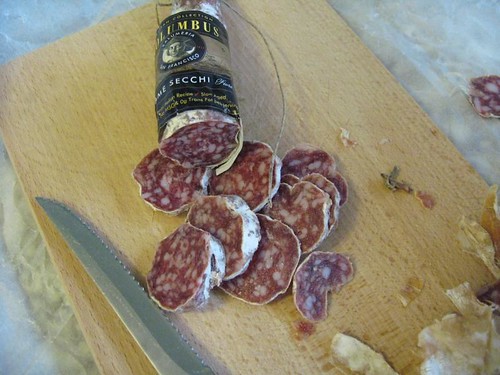
(Photo: Along with the Creminelli cacciatore, the Columbus Artisan Salame Secchi would be an excellent overall choice for pre-dinner appetizers, small parties, and to enjoy with a glass of wine and good bread)
Columbus claims this is their oldest recipe and product and it shows. The Salami Secchi (meaning very dry) is the most subtle of the Columbus salami’s I tried and I love the ratio of fat to pork. The salt and spice seasoning was also idle. This type of Salami is a good all round choice for keeping in the house at all times, while the Finocchiona, for example, would be something that you would consume a little less frequently (just because of the intensity of the fennel seed).
Columbus Cacciatore
My first thought when trying this cacciatore was, wow, this is kind of sweet tasting with lots of deep flavor. It was difficult to pick a winner between the Columbus and Cremenilli cacciatore, but Columbus had an advantage because the product seemed to have been pre-aged and, of course, the sodium nitrates help quicken the hardening process in the refrigerator. I think with more aging time, the Cremenilli would come out on top because of better ingredients (stay tuned!).
Where to Buy
One observation that many of my family members made about both artisan salamis was the price! At between $25 – $30 per pound for the Creminelli product and between $11 – $15 for the Columbus Artisan, the salamis aren’t cheap and are on par with a product like Prosciutto di Parma (which is one of the few Italian cured pork product allowed to be imported into the US). Charging the same amount of money (or more) for a US salumi product is a big risk for hardcore Europeans customers who are particular about value.


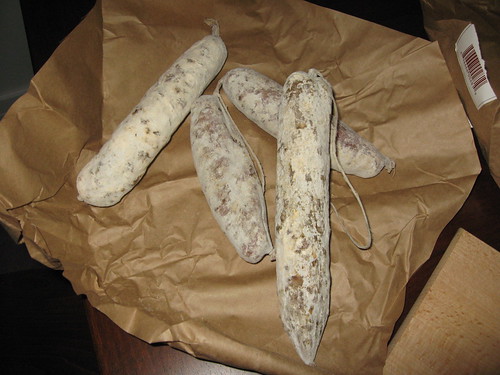
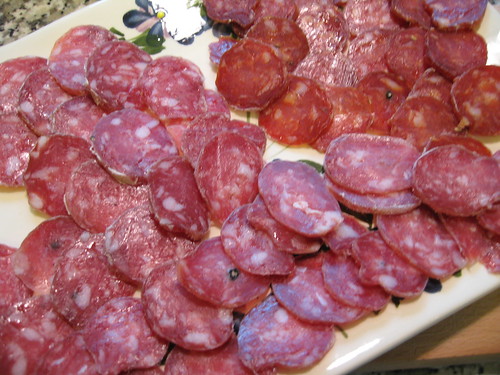
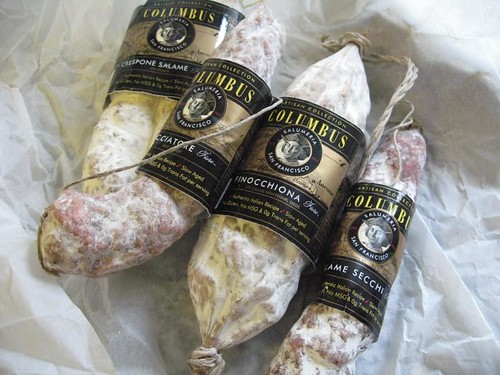
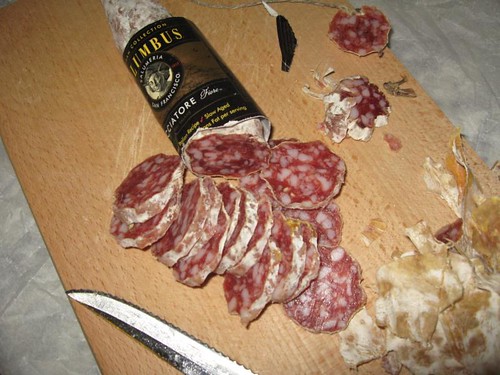


Creminelli Salami Holiday Give Away Contest
(photo: Creminelli owner Cristiano with his artisan salami) Two weeks ago I had the pleasure of tasting and reviewing a wide variety of Creminelli salami, including Cacciatore, Sopressata, and Piccante and the salami was some of the best I’ve tasted…
Tarallini: The Perfect Italian Snack Food
(photo: tarallini made with red pepper flake) I’m going to ask the inevitable question; how many bags of chips did you consume this weekend? And did you include some dips like sour cream and chives or salsa to go with…
How Salami is Made: Meat, Salt, and Time
(photo: the varying parts of a pig, photo courtesy of Meat Salt Time by Tony Seichrist) I have to admit, I have an addiction. Specifically, my addiction is centered on the mighty pig and it’s cured off-spring, Salami! Salumi (the…
La Cucina Povera: The Kitchen of the Poor
(photo: my grandmother and relatives on the family farm during the wheat harvest)What is Cucina Povera?A friend recently asked me to explain the concept of cucina povera and here’s the working definition I came up with :a style of cooking…
The Five Things I Love About Calabria and the Italian Life
(photo: thanks to a wonderful photographer from Calabria, Piero Morello) By now you know my connection to the region of Calabria in southern Italy and my familiar, immigrant, story. You know, for example, my parents immigrated to the U.S. from…
Olli Salumeria Americana Review: Speck, Lomo, Coppa, and Salame
Any time a new salumi company decides to open shop in the United States it’s cause for celebration. And If the same company decides it’s going to raise it’s own heritage hogs in an antibiotic-free (and soon to be organic and…
Cucina Povera by Pamela Sheldon Johns
(photo: the author of Cucina Povera, Pamela Sheldon Johns)If you were to tell people that Italy and American have a few things in common you’d most likely receive some awkward stares. After all, America is a country driv…
My wife recently bought some salami from Fra’ Mani. Wonderful (and spendy!). Glad to see there are some other options. The Fra’ Mani reminded us of our impromptu (and marriage saving) lunch of salumi and foccacia in Sestri Levante (after a long and unpleasant overnight train from Paris to Milan and then Milan to Sestri. Thanks for the info on the other makers.
Jim,
Haven’t tried Fra’ Mani as of yet, but there are, as you said, many options on the market (in relation to about 10-15 years ago) and the quality keeps on improving!